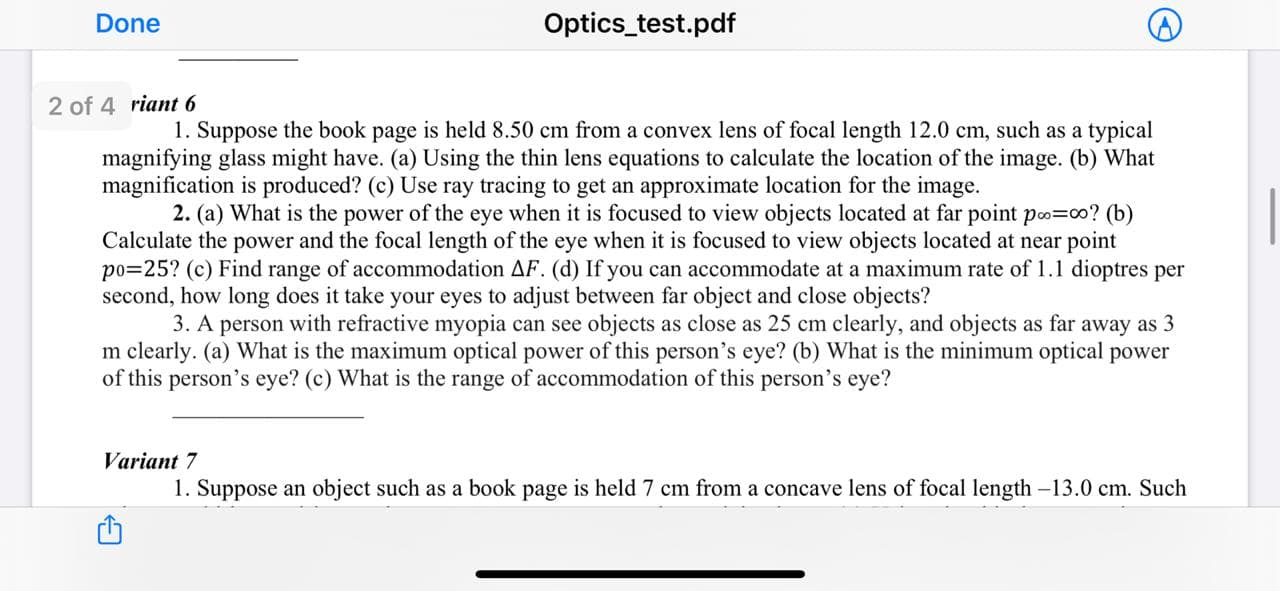Done Optics_test.pdf 2 of 4 riant 6 1. Suppose the book page is held 8.50 cm from a convex lens of focal length 12.0 cm, such as a typical magnifying glass might have. (a) Using the thin lens equations to calculate the location of the image. (b) What magnification is produced? (c) Use ray tracing to get an approximate location for the image. 2. (a) What is the power of the eye when it is focused to view objects located at far point po=c0? (b) Calculate the power and the focal length of the eye when it is focused to view objects located at near point po=25? (c) Find range of accommodation AF. (d) If you can accommodate at a maximum rate of 1.1 dioptres per second, how long does it take your eyes to adjust between far object and close objects? 3. A person with refractive myopia can see objects as close as 25 cm clearly, and objects as far away as 3 m clearly. (a) What is the maximum optical power of this person's eye? (b) What is the minimum optical power of this person's eye? (c) What is the range of accommodation of this person's eye? Variant 7 1. Suppose an object such as a book page is held 7 cm from a concave lens of focal length -13.0 cm. Such
Done Optics_test.pdf 2 of 4 riant 6 1. Suppose the book page is held 8.50 cm from a convex lens of focal length 12.0 cm, such as a typical magnifying glass might have. (a) Using the thin lens equations to calculate the location of the image. (b) What magnification is produced? (c) Use ray tracing to get an approximate location for the image. 2. (a) What is the power of the eye when it is focused to view objects located at far point po=c0? (b) Calculate the power and the focal length of the eye when it is focused to view objects located at near point po=25? (c) Find range of accommodation AF. (d) If you can accommodate at a maximum rate of 1.1 dioptres per second, how long does it take your eyes to adjust between far object and close objects? 3. A person with refractive myopia can see objects as close as 25 cm clearly, and objects as far away as 3 m clearly. (a) What is the maximum optical power of this person's eye? (b) What is the minimum optical power of this person's eye? (c) What is the range of accommodation of this person's eye? Variant 7 1. Suppose an object such as a book page is held 7 cm from a concave lens of focal length -13.0 cm. Such
Principles of Physics: A Calculus-Based Text
5th Edition
ISBN:9781133104261
Author:Raymond A. Serway, John W. Jewett
Publisher:Raymond A. Serway, John W. Jewett
Chapter26: Image Formation By Mirrors And Lenses
Section: Chapter Questions
Problem 10OQ
Related questions
Question
hi
please i need the answers of the questions of varient 6

Transcribed Image Text:Done
Optics_test.pdf
2 of 4 riant 6
1. Suppose the book page is held 8.50 cm from a convex lens of focal length 12.0 cm, such as a typical
magnifying glass might have. (a) Using the thin lens equations to calculate the location of the image. (b) What
magnification is produced? (c) Use ray tracing to get an approximate location for the image.
2. (a) What is the power of the eye when it is focused to view objects located at far point po=c0? (b)
Calculate the power and the focal length of the eye when it is focused to view objects located at near point
po=25? (c) Find range of accommodation AF. (d) If you can accommodate at a maximum rate of 1.1 dioptres per
second, how long does it take your eyes to adjust between far object and close objects?
3. A person with refractive myopia can see objects as close as 25 cm clearly, and objects as far away as 3
m clearly. (a) What is the maximum optical power of this person's eye? (b) What is the minimum optical power
of this person's eye? (c) What is the range of accommodation of this person's eye?
Variant 7
1. Suppose an object such as a book page is held 7 cm from a concave lens of focal length -13.0 cm. Such
Expert Solution
This question has been solved!
Explore an expertly crafted, step-by-step solution for a thorough understanding of key concepts.
This is a popular solution!
Trending now
This is a popular solution!
Step by step
Solved in 4 steps with 4 images

Knowledge Booster
Learn more about
Need a deep-dive on the concept behind this application? Look no further. Learn more about this topic, physics and related others by exploring similar questions and additional content below.Recommended textbooks for you

Principles of Physics: A Calculus-Based Text
Physics
ISBN:
9781133104261
Author:
Raymond A. Serway, John W. Jewett
Publisher:
Cengage Learning

College Physics
Physics
ISBN:
9781285737027
Author:
Raymond A. Serway, Chris Vuille
Publisher:
Cengage Learning

University Physics Volume 3
Physics
ISBN:
9781938168185
Author:
William Moebs, Jeff Sanny
Publisher:
OpenStax

Principles of Physics: A Calculus-Based Text
Physics
ISBN:
9781133104261
Author:
Raymond A. Serway, John W. Jewett
Publisher:
Cengage Learning

College Physics
Physics
ISBN:
9781285737027
Author:
Raymond A. Serway, Chris Vuille
Publisher:
Cengage Learning

University Physics Volume 3
Physics
ISBN:
9781938168185
Author:
William Moebs, Jeff Sanny
Publisher:
OpenStax

Physics for Scientists and Engineers, Technology …
Physics
ISBN:
9781305116399
Author:
Raymond A. Serway, John W. Jewett
Publisher:
Cengage Learning

Physics for Scientists and Engineers
Physics
ISBN:
9781337553278
Author:
Raymond A. Serway, John W. Jewett
Publisher:
Cengage Learning

Physics for Scientists and Engineers with Modern …
Physics
ISBN:
9781337553292
Author:
Raymond A. Serway, John W. Jewett
Publisher:
Cengage Learning